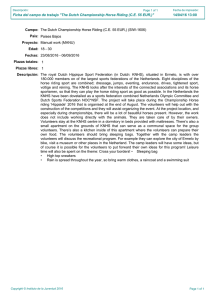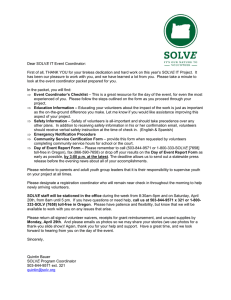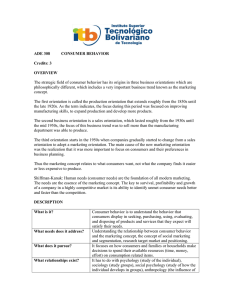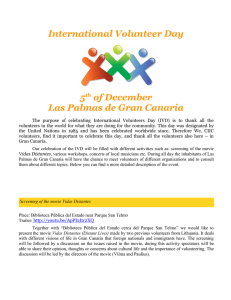Older volunteers` intention to remain in service in
Anuncio
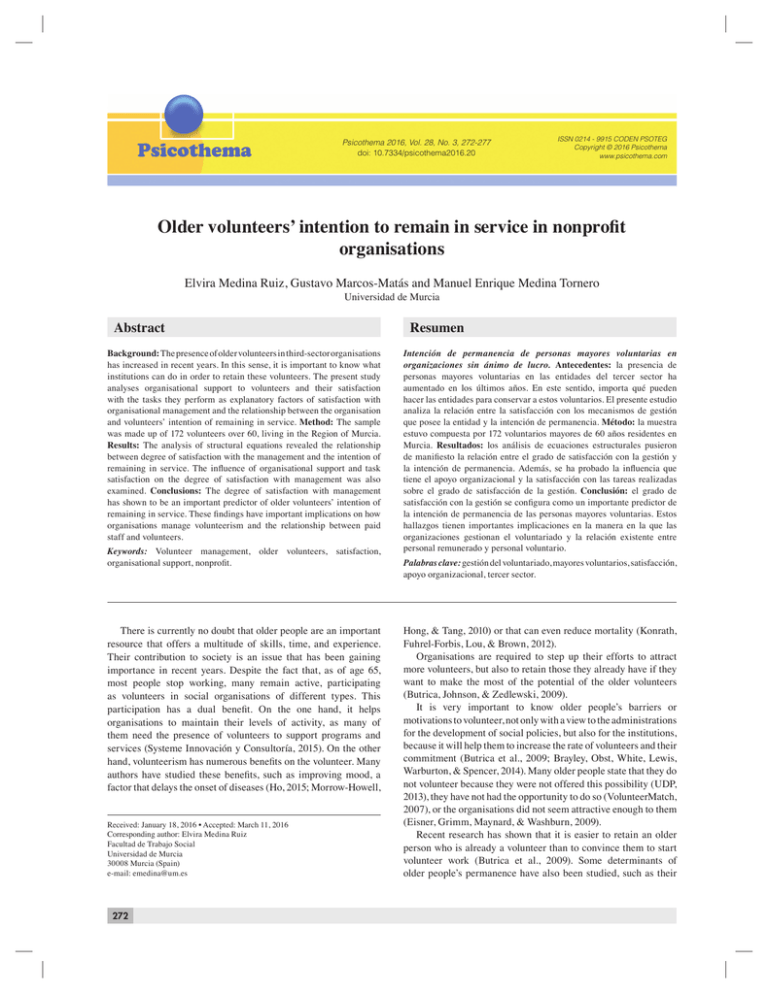
Elvira Medina Ruiz, Gustavo Marcos-Matás and Manuel Enrique Medina Tornero Psicothema 2016, Vol. 28, No. 3, 272-277 doi: 10.7334/psicothema2016.20 ISSN 0214 - 9915 CODEN PSOTEG Copyright © 2016 Psicothema www.psicothema.com Older volunteers’ intention to remain in service in nonprofit organisations Elvira Medina Ruiz, Gustavo Marcos-Matás and Manuel Enrique Medina Tornero Universidad de Murcia Abstract Background: The presence of older volunteers in third-sector organisations has increased in recent years. In this sense, it is important to know what institutions can do in order to retain these volunteers. The present study analyses organisational support to volunteers and their satisfaction with the tasks they perform as explanatory factors of satisfaction with organisational management and the relationship between the organisation and volunteers’ intention of remaining in service. Method: The sample was made up of 172 volunteers over 60, living in the Region of Murcia. Results: The analysis of structural equations revealed the relationship between degree of satisfaction with the management and the intention of remaining in service. The influence of organisational support and task satisfaction on the degree of satisfaction with management was also examined. Conclusions: The degree of satisfaction with management has shown to be an important predictor of older volunteers’ intention of remaining in service. These findings have important implications on how organisations manage volunteerism and the relationship between paid staff and volunteers. Keywords: Volunteer management, older volunteers, satisfaction, organisational support, nonprofit. There is currently no doubt that older people are an important resource that offers a multitude of skills, time, and experience. Their contribution to society is an issue that has been gaining importance in recent years. Despite the fact that, as of age 65, most people stop working, many remain active, participating as volunteers in social organisations of different types. This participation has a dual benefit. On the one hand, it helps organisations to maintain their levels of activity, as many of them need the presence of volunteers to support programs and services (Systeme Innovación y Consultoría, 2015). On the other hand, volunteerism has numerous benefits on the volunteer. Many authors have studied these benefits, such as improving mood, a factor that delays the onset of diseases (Ho, 2015; Morrow-Howell, Received: January 18, 2016 • Accepted: March 11, 2016 Corresponding author: Elvira Medina Ruiz Facultad de Trabajo Social Universidad de Murcia 30008 Murcia (Spain) e-mail: emedina@um.es 272 Resumen Intención de permanencia de personas mayores voluntarias en organizaciones sin ánimo de lucro. Antecedentes: la presencia de personas mayores voluntarias en las entidades del tercer sector ha aumentado en los últimos años. En este sentido, importa qué pueden hacer las entidades para conservar a estos voluntarios. El presente estudio analiza la relación entre la satisfacción con los mecanismos de gestión que posee la entidad y la intención de permanencia. Método: la muestra estuvo compuesta por 172 voluntarios mayores de 60 años residentes en Murcia. Resultados: los análisis de ecuaciones estructurales pusieron de manifiesto la relación entre el grado de satisfacción con la gestión y la intención de permanencia. Además, se ha probado la influencia que tiene el apoyo organizacional y la satisfacción con las tareas realizadas sobre el grado de satisfacción de la gestión. Conclusión: el grado de satisfacción con la gestión se configura como un importante predictor de la intención de permanencia de las personas mayores voluntarias. Estos hallazgos tienen importantes implicaciones en la manera en la que las organizaciones gestionan el voluntariado y la relación existente entre personal remunerado y personal voluntario. Palabras clave: gestión del voluntariado, mayores voluntarios, satisfacción, apoyo organizacional, tercer sector. Hong, & Tang, 2010) or that can even reduce mortality (Konrath, Fuhrel-Forbis, Lou, & Brown, 2012). Organisations are required to step up their efforts to attract more volunteers, but also to retain those they already have if they want to make the most of the potential of the older volunteers (Butrica, Johnson, & Zedlewski, 2009). It is very important to know older people’s barriers or motivations to volunteer, not only with a view to the administrations for the development of social policies, but also for the institutions, because it will help them to increase the rate of volunteers and their commitment (Butrica et al., 2009; Brayley, Obst, White, Lewis, Warburton, & Spencer, 2014). Many older people state that they do not volunteer because they were not offered this possibility (UDP, 2013), they have not had the opportunity to do so (VolunteerMatch, 2007), or the organisations did not seem attractive enough to them (Eisner, Grimm, Maynard, & Washburn, 2009). Recent research has shown that it is easier to retain an older person who is already a volunteer than to convince them to start volunteer work (Butrica et al., 2009). Some determinants of older people’s permanence have also been studied, such as their Older volunteers’ intention to remain in service in nonprofit organisations personal characteristics (Li, Chen &, Chen, 2013), the time they have been volunteers, and the hours dedicated to volunteerism (CNCS, 2007). This gives us an idea of the need to implement efficient management procedures to maximize the quality of the programs, volunteer satisfaction, and the retention of volunteers in organisations (Chacón & Vecina, 2002; Vecina, Chacón, & Sueiro, 2009). An older volunteer may decide to quit volunteering for many reasons (illness, change of address, family obligations...), not all of them controllable by the organisation, but a dissatisfied and discontented volunteer does not need more than this to quit and will probably abandon the activity within a short period of time (Dávila, 2008). It is therefore important for organisations to focus on retaining older volunteers and to maximize their commitment. What determines a volunteer’s satisfaction and desire to continue in the organisation? There are currently various models that explain volunteers’ behaviour within the organisation and their consequent permanence (Arias & Barrón, 2008; Dávila, 2003; Omoto & Snyder, 1995; Vecina et al., 2009). Several authors have shown that the greatest predictor of volunteers’ continuity in the organisation is their intention of remaining in service (Arias & Barrón, 2008; Dávila, 2003; Finkelstein, Penner, & Brannick, 2005; Vecina, Chacón, & Sueiro, 2010), as well as other factors that relate to this intention: their motivations (Cabrera-Darias & Marrero-Quevedo, 2015; Geiser, Okun, & Grano, 2014; Morrow-Howell & Mui, 1989; Okun, Barr, & Herzog, 1998), support by the organisation (Black & Kovacs, 1996; Penner, 2002; Tang, Morrow-Howell, & Choi, 2010), previous time in the organisation (CNCS, 2007), the tasks they perform (Gidron, 1985; Hackman & Oldham, 1975; Vecina et al., 2009), the persons with whom they relate within the organisation (Greensalde & White, 2005; Rotolo, 2000; Rotolo & Wilson, 2006), or the way the organisation manages volunteerism (Vecina et al., 2009). This variety of factors is due, in part, to the lack of consensus either in the dimensions or in the number of items of the factors involved when assessing the intention of permanence and satisfaction (Vecina et al., 2009). Some researchers focused on a single dimension of satisfaction (Penner & Filkelstein, 1998), whereas others addressed its multidimensional nature (Gidron, 1985; Galindo-Kuhn & Guzley, 2001; Vecina et al., 2009). The objective of this study was to analyze how a series of factors, such as organisational support and the degree of satisfaction with the tasks that are assigned to them, can explain older volunteers’ intention of remaining in service by improving their satisfaction with the management. The working hypothesis is based on the idea that the management of volunteers carried out by the organisations will determine older volunteers’ satisfaction and their intention of remaining in service. Specifically, we study how the support provided by the organisation and volunteers’ satisfaction with the tasks determine their satisfaction with the management mechanisms, and how this can explain their intention of remaining in service. Methods Participants Participants in the study were 172 volunteers over 60 years old who performed their volunteer work in different organisations in the socio-assistential areas of the Region of Murcia. Concerning sex, 57.6% of the sample are women and 42.4% are men. Their mean age is 69 years. On average, they have been volunteers for 8 years and they spend an average of 8 hours per week, 8 days a month on volunteer work. Regarding the level of studies completed, 5.2% has no studies, 19.2% has completed primary studies, 19.8% have secondary education, 10.5% have vocational training, and 41.9% have university studies. Likewise, 3.5% stated they have another type of training. In terms of marital status, 14% are single, 64% are married, 5.2% are separated or divorced, and 16.9% are widowed. Regarding religious attitudes, 80.8% are practicing believers. Instruments The instrument used was a questionnaire created ad hoc. The measurement scales are based on the literature and were adapted when necessary with the feedback from prior interviews and pretests: – Intention of remaining in service. We used the scale developed by Dávila (2003) witch includes three items of intention of remaining in the organisation at 6, 12, and 24 months on a Likert scale ranging from 1 (very unlikely) to 7 (very likely). Thus, the scale does not only reflect the shortterm intention of remaining, but also the one and two years’ willingness to remain in service. – Satisfaction with the management of the organisation. This construct was measured with nine items rated on a 7-point scale ranging from 1 (totally dissatisfied) to 7 (completely satisfied), which included aspects related to the management from the first seven studies of Vecina et al. (2009) on the frequency and quality of communications, training, and acknowledgment, among others. The other two measured the degree of satisfaction with supervision and the presence of incentives. – Organisational support. This scale included four items rated on a 7-point scale ranging from 1 (totally dissatisfied) to 7 (completely satisfied), extracted and adapted from the “Inventario de Recursos Sociales de Ancianos” (Inventory of Older People’s Social Resources) of Díaz-Veiga (1985). Organisational support scale evaluated the type of support (both emotional and instrumental), the frequency of contact, and the degree of overall satisfaction with the relationship. – Task satisfaction. We included three items rated on a 7-point scale ranging from 1 (totally dissatisfied) to 7 (completely satisfied). The first two were extracted from the Job Diagnostic Survey of Hackman and Oldham (1975) and the third was extracted from Vecina et al. (2009). Control variables. Control variables contributes to the validity of the model, as with them, the core effect of concepts is better isolated. We included two variables in the analyses: time committed (number of hours they spend on volunteer work) (Okun, 1994; Wilson & Musik, 1999) and seniority of volunteers (amount of time they have been doing the activity). The scales used in the measurement model are made from formative indicators. In this type of scales, each item, referring to the different dimensions of the concepts, contributes or adds to 273 Elvira Medina Ruiz, Gustavo Marcos-Matás and Manuel Enrique Medina Tornero the latent construct (Fornell & Larcker, 1981). According to the methodology described by Rossiter (2002) for formative scales, we have included the most relevant components of each of the concepts supported by literature and the opinion and feedback from the prior interviews and pretests. Procedure We collected data from nonprofit organisations of the Region of Murcia that had volunteers over 60 years old. We used as sampling frame the directories of the two major nonprofit organisation platforms (Plataforma del Voluntariado and Coordinadora ONGD). From these contacts (32) and some others from reference organisations not included in the directories (2), we reached 19 organisations with older volunteers that were willing to participate. The application of the questionnaire varied depending on each organisation, in an attempt to interfere as little as possible in its regular activities. The research team handed out most of them personally, others were arranged in group sessions and some of of them passed out by the person in charge of the organisation’s volunteerism. Data analysis To test the hypotheses, we used structural equation modelling. The analyses were conducted following the Partial Least Squares (PLS) methodology, which is especially useful to test theories when formative measures, many latent variables and limited sample size are involved (Henseler, Ringle, & Sinkovics, 2009; Chin, 1998). Both measurement and structural models were estimated with SmartPLS 2.0 M3 software (Ringle, Wende, & Will, 2005). Results In order to evaluate the measurement model, we need to test the validity of the scales used. To assess the validity of the formative constructs, we used the weight of each indicator for each latent construct according to criteria of significance regardless of size (Chin, 1998). The estimation of this validity was performed within the PLS approach with the bootstrapping technique, which calculates the weights of the items on the construct and their significance. In that regard, several items of some scales were removed because their weights were not statistically significant. The validity of the scales was confirmed as the weights of the items were sufficiently significant. Table 1 shows the weights and t-values for each of the items of the scales. In addition, in order to evaluate the quality of the responses, we assessed the existence of common method bias using Harman’s single-factor test. This result of this test did not indicate the presence of common method bias, as the solution of the unrotated factor analysis reveals the existence of multiple factors, where none of them accumulated most of the variance. The first factor accumulated the largest covariance with 25.2%, less than the 50% preferred as the limit to consider the existence of such bias (Podsakoff, Mackenzie, Lee, & Podsakoff, 2003). To assess the structural model by PLS, the variance of the dependent latent variables explained by the independent variables that predict them (R2) must be considered and, in particular, the 274 significance of the coefficients associated with the proposed relationships must be assessed (Cepeda & Roldán, 2008). In our case, the dependent variables are satisfaction with the tasks, satisfaction with the management mechanisms, and intention of remaining in service. The value of R2 expresses the proportion of variance of the dependent variable that is explained by the independent variable, so the closer it is to one, the more explanatory power the model will have, always bearing in mind that R2 must not be less than .1 (Falk & Miller, 1992). The model had sufficient predictive power to explain the variable satisfaction with management (R2 = .49) and somewhat more limited power to explain the variable intention of remaining in service (R2 = .14). When analyzing the size of R2 as a criterion of predictive significance, the technique of reusing the sample proposed by Stone (1974) and Geisser (1975) can be applied through the blindfolding process. This technique consists of omitting part of the data when estimating a dependent variable from other independent variables, and then attempts to estimate those data by using previously estimated parameters. This process is repeated until each datum has been omitted and estimated. This technique calculates a statistic known as Q2 that represents a measure of how well the observed values are reconstructed from the estimated parameters. For the model to have predictive validity, Q2 must be greater than zero. The model shows an adequate predictive capacity, as both for the variable satisfaction with management mechanisms (Q2 = .27) and intention of remaining in service (Q2 = .11), Q2 is greater than zero (Geisser, 1975). Table 1 Weights and t-values Construct Item Weights t-value IR1 .36 6.33 IR2 .34 9.90 IR3 .42 7.01 SMA1 .13 9.27 SMA2 .14 8.02 SMA3 .17 1.40 SMA4 .14 10.79 SMA5 .16 12.17 SMA6 .16 16.18 SMA7 .17 11.81. SMA8 .09 4.55 SMA9 .17 11.42 ST1 .38 6.22 ST2 .32 4.96 ST3 .46 7.63 ST4 .21 3.01 OS1 .29 20.30 OS2 .28 30.68 OS3 .25 23.15 OS4 .27 21.88 Seniority of volunteers VT 1 – Time committed TC 1 – Intention of remaining in service Satisfaction with management Task Satisfaction Organisational support Note: Probability of critical t-values: p<.10 for t>1.65; p<.05 for t>1.96 and p<.01 for t>2.58 Older volunteers’ intention to remain in service in nonprofit organisations After analyzing these statistics, we present a summary of the contrast of the structural model. For this purpose, Table 2 shows the estimates of the standardized coefficients for the proposed relations and their t-values, obtained through bootstrapping. Additionally, Figure 1 presents the path coefficients or standardized regression weights, indicating their significance according the t-values obtained by bootstrapping (Chin, 1998). Table 2 Standardised coefficients (β) and t-values Hypotheses β t-value H1 Task Satisfaction ÆSatisfaction with management .25 2.79*** H2 Organisational supportÆSatisfaction with management .55 7.51*** H3 Satisfaction with managementÆ Intention of remaining in service .32 4.08*** Note: * p<.10, ** p<.05; *** p<.01; n.s.: non-significant Satisfaction with the tasks .25*** Satisfaction with .31*** management Organization support Intention of remaining in service .55*** Control variables Seniority of volunteers Time committed Figure 1. Theoretical model and results Note: * p<0.10, ** p<0,05; *** p<0,01; n.s.: non-significant The results show a significant estimation in the predicted direction for all the relationships proposed in the theoretical model. In particular, the results show a positive relationship between satisfaction with the tasks and satisfaction with management (H1). The proposed relationship between the support provided to volunteers by the organisation —what we call organisational support—with satisfaction with the management was also confirmed (H2). Finally, volunteers’ degree of satisfaction with the management mechanisms of the organisation positively influences their intention of remaining in service (H3). Discussion Currently, the third sector is supported mainly by the presence of volunteers. On average, volunteerism represents 71.5% of the total number of people working in the sector (Systeme Innovación y Consultoría, 2015). There is a trend towards the ageing of volunteers in this scenario, with a greater presence of people over 55. This raises the need to improve the management of volunteerism, approaching a model that guarantees quality and stability. However, in Spain, the percentage of seniors who perform volunteer work continues to be lower than in the rest of Europe (Wahrendorf, Blane, Matthews, & Siegrist, 2015). For this reason, it is important for organisations and the Administration to promote older people’s volunteerism, given the relevant benefits it produces in society and in their own aging process (Chong, Roselle, & Liu, 2013) by improving their subjective well-being and self-esteem, as an agent of active and healthy ageing. In this sense, the latest law regulating volunteerism in Spain (45/2015 of 14 October14, of Volunteerism) advocates a greater professionalisation of management and particularly mentions senior citizens’ volunteerism. The results of the study have provided empirical evidence of the importance of satisfaction with management with regard to the intention of remaining in service. Various authors support this relationship and show the importance of addressing aspects such as supervision (Lafer, 1991; Tsai, 2001; UDP, 2013), training (Cáritas Española, 2009), acknowledgment (Wahrendorf et al., 2015; Eisner et al., 2009), the quality and frequency of communications, the existence of incentives within and outside of the organisation (Chinman & Wandersman, 1999). The importance both of the emotional and material support by the organisations with which volunteers collaborate (Arias & Barrón, 2008) and their impact on satisfaction with the organisation’s management mechanisms the has also been shown (Stevens, 1991). It is vitally important to sensitize and train the workers about the role of the volunteer within the organisation in order to avoid mistrust and to produce a collaborative, positive relationship (The Urban Institute, 2004). The influence of the tasks that the volunteers perform on their satisfaction with management has also been shown. In this sense, special attention should be paid to the type of task that is assigned to volunteers, taking into account that many of them are highly qualified (Bradley et al., 2014) and may be seeking in volunteerism a way of putting into practice the skills they acquired during their lifetime (Salt & Mikkelsen, 2009). In the coming years, social entities will need the cooperation of many volunteers and, predictably, many of them will be older people. In our opinion, it would be interesting to encourage participation before retirement, when they are younger and are still working (Butrica et al., 2009; Zedlewski, 2007). In this sense, the companies and the public administration play an essential role to encourage and facilitate this involvement. It would be of interest to expand the sampling to all Spain for more generalizable results, as the sample focused on a specific territorial area. It would also be interesting to study the impact of other variables such as organisational conflict or commitment. References Arias, A., & Barrón, A. (2008). El apoyo social en la predicción a corto y medio plazo de la permanencia del voluntariado socioasistencial [Social support in the short- and middle-term prediction of welfare volunteers’ permanence]. Psicothema, 20(1), 97-103. Black, B., & Kovacs, P. J. (1996). Direct care and nondirect care hospice volunteers: motivations, acceptance, satisfaction and length of service. The Journal of Volunteer Administration, 14(2), 21-32. 275 Elvira Medina Ruiz, Gustavo Marcos-Matás and Manuel Enrique Medina Tornero Bradley, N., Obst, P., White, K. M., & Lewis, I. M. (2014). Exploring the validity and predictive power of an extended volunteer functions inventory within the context of episodic skilled volunteering by retirees. Journal of Community Psychology, 42(1), 1-18. Butrica, B. A., Johnson, R. W., & Zedlewski, S. R. (2009). Volunteer dynamics of older Americans. Journal of Gerontology: Social Sciences, 64(5), 644-655. Cabrera-Arias, M. E., & Marrero-Quevedo, R. J. (2015). Motivos, personalidad y bienestar subjetivos en el voluntariado [Motives, personality and subjective well-being in volunteering]. Anales de Psicología, 31(3), 791-801. Cáritas Española (2009). Voluntariado y personas mayores. Material formative [Volunteerism and older people: Formative material]. Madrid: Cáritas Española Editores. Cepeda, G., & Roldán, J. (2008). Aplicando en la práctica la técnica PLS en la administración de empresas [Applying the PLS technique in practice in business administration]. University of Seville. Retrieved from ciberconta.unizar.es/doctorado/PLSGabrielCepeda.pdf Chacón, F., & Vecina, M. L. (2002). Gestión del voluntariado [Volunteering management]. Madrid: Síntesis. Chinman, M., & Wandersman, A. (1999). The benefits and costs of volunteering in community organizations: Review and practical implications. Nonprofit and Voluntary Sector Quarterly, 28(1), 46-64. Chin, W. W. (1998). Issues and opinion on structural equation modeling, MIS Quarterly, 22(1), 7-15. Chong, A. M., Roselle, T. L., & Liu, S. (2013). Volunteerism and positive aging in Hong Kong: A cultural perspective. The International Journal of Aging and Human Development, 77(3), 211-231. Corporation for National and Community Service (CNCS) (2007). Volunteer Supplement to the Current Population Survey, 2005-2007. Washington, D.C: Corporation for National and Community Service. Dávila, M. C. (2003). La incidencia diferencial de los factores psicosociales en distintos tipos de voluntariado [Differential incidence of psychosocial factors in different types of volunteers] (Unpublished doctoral thesis). Complutense University of Madrid, Madrid, Spain. Dávila, M. C. (2008). Abandono del voluntariado. Tasas de abandono y causas más frecuentes [Volunteers’ drop out. Drop out rates and common causes]. Comunicación e Cidadanía, 5. Díaz-Veiga, P. (1985). Evaluación del apoyo social y comportamiento afectivo en ancianos [Assessment of social support and affective behavior in older people]. Degree Report. Autonomous University of Madrid. Madrid (Spain). Eisner, D., Grimm, R., Maynard, S., & Washburn, S. (2009). The New Volunteer Workforce. Stanford, California: Stanford Social Innovation Review. Falk, R. F., & Miller, N. B. (1992). A primer for soft modeling. Akron, OH: University of Akron Press. Finkelstein, M. A., Penner, L. A., & Brannick, M. T. (2005). Motive, role identity and prosocial personality as predictors of volunteer activity. Social Behavior and Personality, 33(4), 403-418. Fornell, C., & Larcker, D. F. (1981). Evaluating structural equation models with unobservable variables and measurement error. Journal of Marketing Research, 18(1), 39-50. Galindo-Kuhn, R., & Guzley, R. M. (2001). The Volunteer Satisfaction Index: Construct definition, measurement, development and validation. Journal of Social Service Research, 28(1), 45-68. Geisser, S. (1975). The predictive sample reuse method with applications. Journal of the American Statistical Association, 70(350), 320-328. Gidron, B. (1985). Prediction of retention and turnover among service volunteer workers. Journal of Social Service Research, 8(1), 1-16. Greenslade, J. H., & White, K. M. (2005). The prediction of above-average participation in volunteerism: A test of the theory of planned behavior and the volunteers functions inventory in older australian adults. The Journal of Social Psychology, 145(2), 155-172. Hackman, J. R., & Oldham, G. R. (1975). Development of the Job Diagnostic Survey. Journal of Applied Psychology, 60(2), 159-170. Henseler, J., Ringle, C. M., & Sinkovics, R. R. (2009). The use of partial least squares path modeling in international marketing. In Rudolf R. Sinkovics, Pervez N. Ghauri (Eds.), New Challenges to International Marketing (pp. 277-319). Emerald Group Publishing Limited. Ho, H. C. (2015). Elderly volunteering and psychological well-being. International Social Work, 25. Retrieved from http://isw.sagepub.com/ content/early/2015/11/25/0020872815595111.abstract 276 Konrath, S, Fuhrel-Forbis, A., Lou, A., & Brown, S. (2012). Motives for volunteering are associated with mortality risk in older adults. Health Psychology, 31(1), 87-96. Lafer, B. (1991). The attrition of hospice volunteers. Omega Journal of Death and Dying, 23(3), 161-168. Li, Y. P., Chen, Y. M., & Chen, C. H. (2013). Volunteer transitions and physical and psychological health among older adults in Taiwan. Journals of Gerontology, Series B: Psychological Sciences and Social Sciences, 68(6), 997-1008. Morrow-Howell, N., & Mui, A.C. (1989). Elderly volunteers: Reasons for initiating and terminating service. Journal of Gerontological Social Work, 13(3), 21-34. Morrow-Howell, N., Hong, S. L., & Tang, S. (2009). Who benefits from volunteering? Variations in perceived benefits. The Gerontologist, 49(1), 91-102. Okun, M. A. (1994). The relation between motives for organizational volunteering and frequency of volunteering by elders. Journal of Applied Gerontology, 13(2), 115-127. Okun, M. A., Barr, A., & Herzog, A. R. (1998). Motivation to volunteer by older adults: A test of competing measurement models. Psychology and Aging, 13(4), 608-621. Omoto, A. M., & Snyder, M. (1995). Sustained helping without obligation: Motivation, longevity of service, and perceived attitude change among AIDS volunteers. Journal of Personality and Social Psychology, 68(4), 671-686. Penner, L. A. (2002). Dispositional and organizational influences on sustained volunteerism: An interactionist perspective. Journal of Social Issues, 58(3), 447-467. Penner, L. A., & Finkelstein, M. A. (1998). Dispositional and structural determinants of volunteerism. Journal of Personality and Social Psychology, 74(2), 525-537. Podsakoff, P. M., MacKenzie, S. B., Lee, J-Y., & Podsakoff, N. P. (2003). Common method biases in behavioral research: A critical review of the literature and recommended remedies. Journal of Applied Psychology, 88(5), 879-903. Ringle, C. M., Wende, S., & Will, A. (2005). SmartPLS 2.0.M3. Hamburg: SmartPLS. Retrieved from http://www.smartpls.com Rossiter, J. (2002). The C-OAR-SE procedure for scale development in marketing, International Journal of Research in Marketing, 19(4), 305-335. Rotolo, T. (2000). A time to join, a time to quit: The influence of life cycle transitions on voluntary association membership. Social Forces, 78(3), 1133-1161. Rotolo, T., & Wilson, J. (2006). Substitute or complement? Spousal influence on volunteering. Journal of Marriage and Family, 68(2), 305-319. Salt, B., & Mikkelsen, S. (2009). Monash Baby Boomer Study. Monash, Melbourne, Australia: KPMG. Stevens, E.S. (1991). Toward satisfaction and retention of senior volunteers. Journal of Gerontological Social Work, 16(3), 33-41. Stone, M. (1974). Cross-validatory choice and assessment of statistical predictions. Journal of the Royal Statistical Society, Series B, 36(2), 111-113. Systeme Innovación y Consultoría (2015). El tercer sector de acción social en 2015: impacto de la crisis [The third-sector of social action in 2015: Impact of the crisis]. Madrid: Plataforma del Tercer Sector. Tang, F., Morrow-Howell, N., & Choi, E. (2010). Why do older volunteers stop volunteering? Ageing & Society, 30(5), 859-878. The Urban Institute (2004). Volunteer management capacity in America’s charities and congreations, 2004. Washington, DC: Urban Institute. Tsai, C. F. (2001). An exploration of volunteers’ motivation and job satisfaction in Arkansas literacy councils. Dissertation Abstracts International Section A: Humanities and Social Sciences, 61(9), 3442. UPD (2013). Voluntariado Social UDP: Tal como somos [UDP Social Volunteering: Just as we are]. Madrid: Unión Democrática de Pensionistas y Jubilados de España (UPD). Vecina, M. L., Chacón, F., & Sueiro, M. J. (2009). Satisfacción en el voluntariado: estructura interna y relación con la permanencia en las organizaciones [Volunteer satisfaction: Internal structure and relationship with permanence in organizations]. Psicothema, 21(1), 112-117. Older volunteers’ intention to remain in service in nonprofit organisations Vecina, M. L., Chacón, F., & Sueiro, M. J. (2010). Differences and similarities among volunteers who drop out during first year and volunteers who continue after eight years. The Spanish Journal of Psychology, 13(1), 343-352. Wahrendorf, M., Blane, D., Matthews, K., & Siegrist, J. (2015). Linking quality of work in midlife to volunteering during retirement: A European study. Journal of Population Ageing, 8, 1-18. Wilson, J., & Musick, M. (1999). Attachment to volunteering. Sociological Forum, 14(2), 243-272. Zedlewski, S. R. (2007). Will retiring boomers form a new army of volunteers? Perspectives on Productive Aging, 7. Washington, DC: Urban Institute. Retrieved from http://www.urban.org/sites/default/ files/alfresco/publication-pdfs/411579-Will-Retiring-Boomers-Forma-New-Army-of-Volunteers-.PDF. 277

